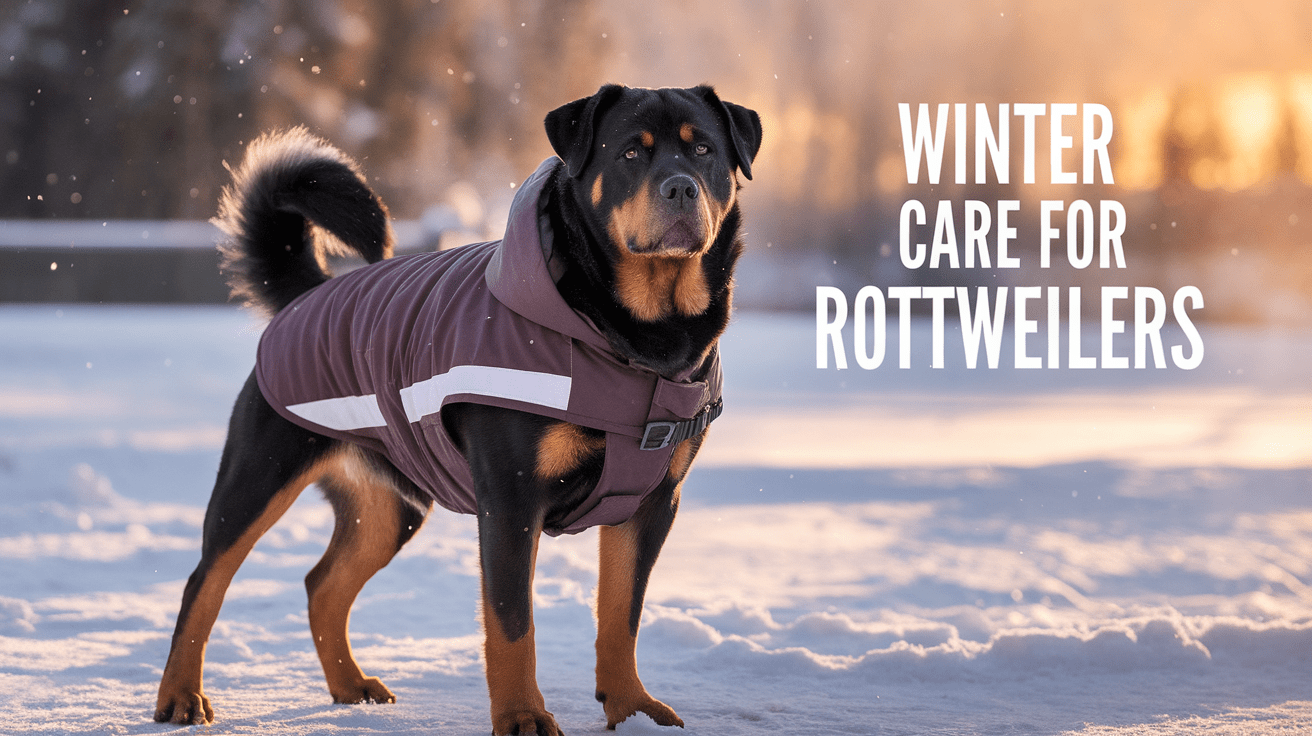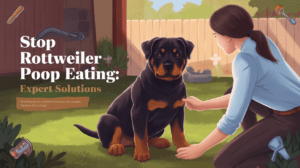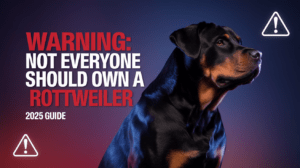Winter Care Guide for Rottweilers 2025 Key Takeaways
- ✓ Living Space: Create a draft-free sleeping area with elevated beds and maintain indoor temperatures between 68-72°F (20-22°C).
- ✓ Grooming: Brush your Rottweiler twice weekly and protect their paws with balm and proper boots during winter activities.
- ✓ Diet: Increase daily calories by 10-15% during winter months and ensure consistent water intake with heated water bowls.
- ✓ Exercise: Opt for shorter, more frequent exercise sessions and avoid peak cold hours for outdoor activities.
- ✓ Health Monitoring: Schedule regular vet check-ups and watch for signs of arthritis, respiratory issues, and dry skin conditions.
As winter approaches, ensuring your Rottweiler’s comfort and safety during cold weather becomes crucial. While these powerful dogs have a thick double coat, they still need special attention when temperatures drop. According to the American Veterinary Medical Association, even breeds with thick coats can experience cold-related health issues if proper precautions aren’t taken.
Having treated countless Rottweilers during my 15 years of veterinary practice, I’ve seen firsthand how proper winter care can make a significant difference in their well-being. Just last winter, I helped a Rottweiler named Max overcome severe paw pad issues because his owner wasn’t aware of proper winter protection – a situation that’s entirely preventable with the right knowledge.
In this comprehensive guide, we’ll explore essential winter care strategies for your Rottweiler, from creating cozy indoor spaces to maintaining proper exercise routines. Whether you’re a first-time Rottweiler owner or an experienced enthusiast, these 2025 updated guidelines will help keep your furry friend healthy and happy throughout the cold season.
Preparing Your Rottweiler’s Living Space for Winter
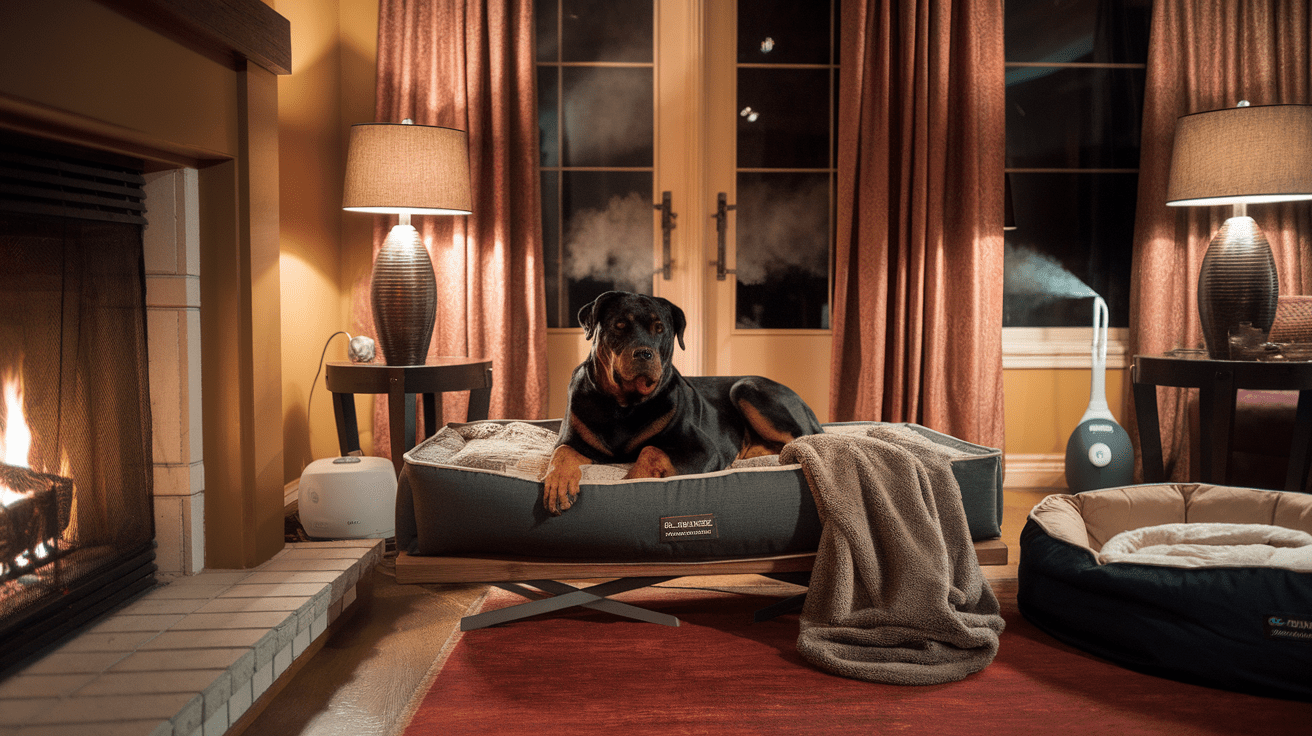
Creating a winter-ready environment for your Rottweiler isn’t just about comfort – it’s essential for their health and well-being. During my years of practice, I’ve observed that Rottweilers who have properly prepared living spaces handle winter months significantly better than those without adequate arrangements.
Insulating Indoor Spaces and Creating Warm Bedding Areas
According to a study in the Journal of Veterinary Behavior, dogs spend up to 80% of their time resting in their designated spaces during winter months. Your Rottweiler needs a draft-free sleeping area away from cold windows and doors. I recommend:
• Elevated beds to prevent cold from seeping up from the floor
• Thick, washable bedding materials that retain warmth
• Multiple sleeping options in different rooms
Setting Up Protected Outdoor Areas and Exercise Spaces
While Rottweilers are robust dogs, they still need protection when spending time outdoors. Last winter, I worked with a family who transformed their backyard into a winter-safe zone for their Rottweiler, Max, by creating:
• A covered patio area for shelter from snow and wind
• Non-slip pathways cleared of ice and snow
• A designated potty area that’s easily accessible
• Windbreaks around favorite outdoor spots
Managing Humidity and Temperature Control
Indoor climate control is crucial for your Rottweiler’s comfort. The ideal indoor temperature should stay between 68-72°F (20-22°C). Consider these essential factors:
• Use humidifiers to prevent dry air from irritating your dog’s respiratory system
• Monitor indoor temperature, especially when you’re away
• Ensure proper ventilation while maintaining warmth
• Place draft excluders under doors
Remember, your Rottweiler might show signs of discomfort like excessive shivering or seeking warm spots if their living space isn’t properly winterized. Watch for these signals and adjust accordingly. The goal is to create a comfortable microclimate that allows your Rottweiler to thrive during the cold months while maintaining their natural activity levels.
Winter Health and Grooming Requirements
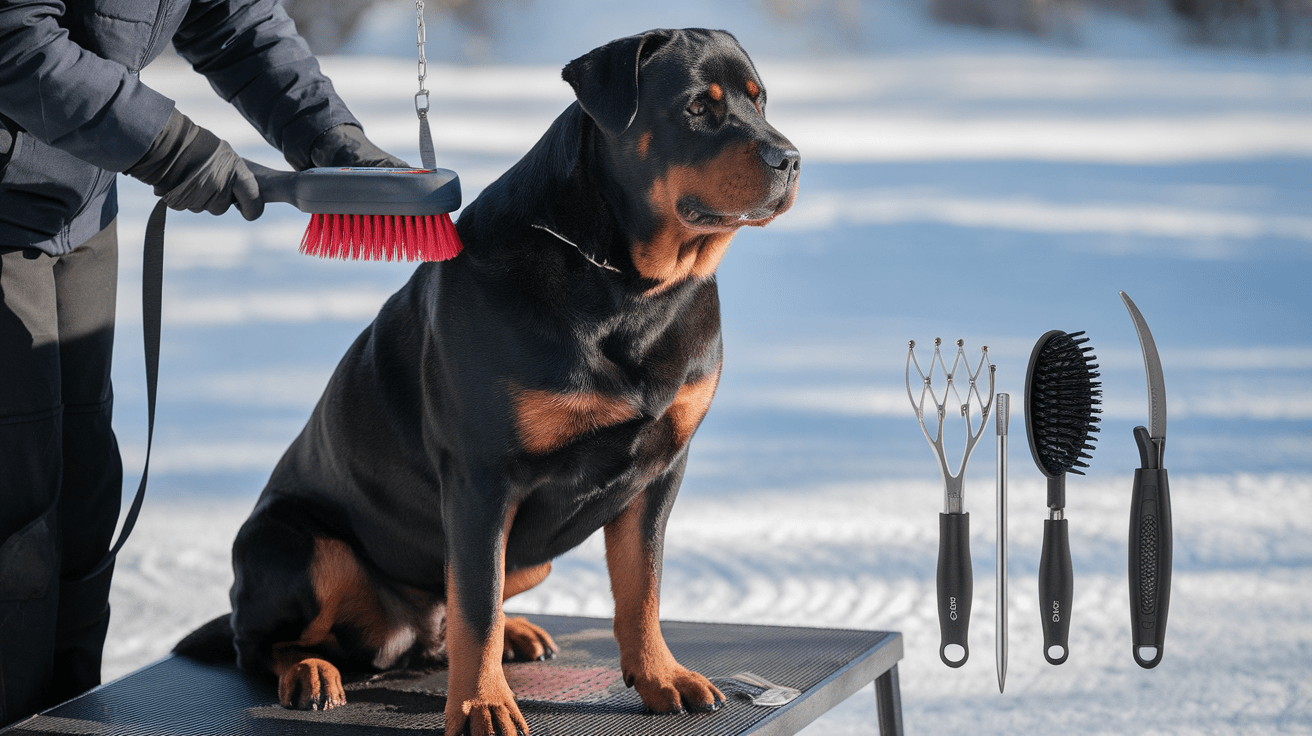
During winter months, your Rottweiler’s health and grooming needs require special attention. According to a study in Frontiers in Veterinary Science, winter-related health issues in large breeds like Rottweilers can increase by up to 40% without proper care. As someone who’s treated numerous winter-related cases, I can’t stress enough the importance of a comprehensive grooming routine.
Cold Weather Coat Care and Maintenance
Your Rottweiler’s double coat serves as natural insulation, but it needs proper maintenance to function effectively. I recently treated a Rottweiler whose undercoat became severely matted during winter, leading to skin infections. To prevent such issues:
• Brush your dog at least twice weekly to remove dead hair and prevent matting
• Keep the coat clean but avoid over-bathing which can strip natural oils
• Use appropriate winter-specific grooming tools like undercoat rakes
• Consider using a coat conditioner to prevent dry skin
Paw Protection and Winter-Specific Hygiene
Winter can be particularly harsh on your Rottweiler’s paws. Think of their paw pads as similar to our bare feet on cold surfaces – they need protection. Essential paw care includes:
• Trimming the fur between paw pads to prevent ice ball formation
• Applying pet-safe paw balm before outdoor activities
• Wiping paws after walks to remove salt and de-icing chemicals
• Using properly fitted dog boots for extended outdoor activities
Preventing Common Winter Health Issues
From my experience, prevention is always better than cure. Winter brings specific health challenges for Rottweilers, including:
• Arthritis flare-ups – Keep your dog warm and consider joint supplements
• Respiratory issues – Maintain good indoor air quality
• Dry skin conditions – Use a humidifier and appropriate moisturizing products
• Cracked paw pads – Regular moisturizing and protection is crucial
Remember to schedule regular vet check-ups during winter months. Just last week, I caught early signs of winter-related arthritis in a 7-year-old Rottweiler during a routine examination, allowing us to start treatment before it became severe. Early detection and prevention are key to maintaining your Rottweiler’s health during the cold season.
Winter Diet and Exercise Adjustments
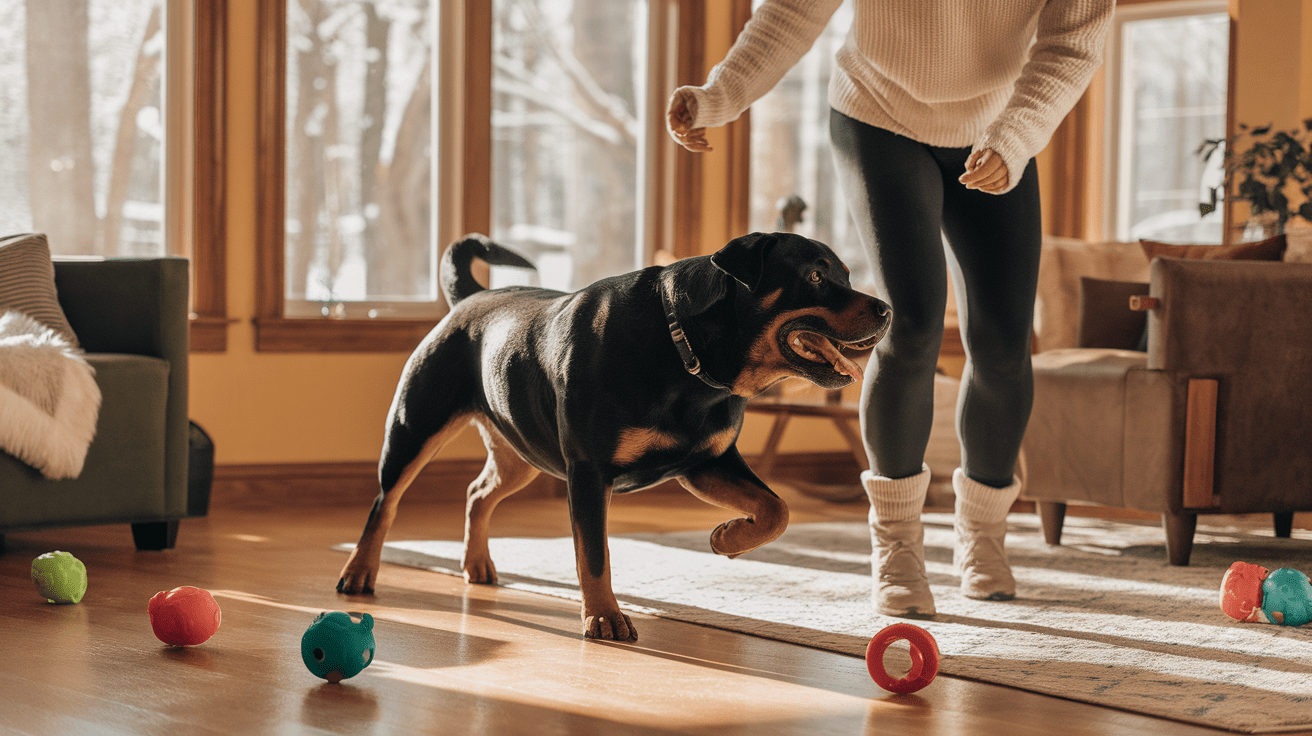
Winter months require specific adjustments to your Rottweiler’s diet and exercise routine. According to a study in The Veterinary Journal, large breed dogs can experience up to a 30% increase in energy expenditure during cold weather just to maintain body temperature. As someone who’s guided countless Rottweiler owners through seasonal transitions, I’ve seen how proper dietary and exercise modifications can significantly impact their winter well-being.
Modifying Caloric Intake for Cold Weather
Just last month, I worked with a Rottweiler named Bruno whose energy levels were noticeably low during winter walks. After adjusting his caloric intake, we saw a remarkable improvement. Here’s what you should consider:
• Increase daily calories by 10-15% during peak winter months
• Add healthy fats like fish oil to support coat health and energy levels
• Maintain consistent feeding times to regulate metabolism
• Monitor body condition score regularly to prevent winter weight gain
Safe Exercise Routines During Winter Months
Exercise needs don’t diminish in winter, but the approach must change. Think of it like our own winter workout adjustments – we need to be more strategic and safety-conscious. Essential winter exercise guidelines include:
• Shorter, more frequent exercise sessions instead of long ones
• Indoor activities like hide-and-seek or stair climbing on extremely cold days
• Avoiding exercise during peak cold hours (early morning and late evening)
• Warming up muscles properly before outdoor activities
Hydration and Supplement Needs in Cold Weather
Many owners don’t realize that winter dehydration is as common as summer dehydration. In my practice, I’ve seen numerous cases of winter dehydration simply because dogs drink less in cold weather. Consider these important factors:
• Keep water from freezing by using heated water bowls
• Consider adding warm water to dry food to increase moisture intake
• Monitor for signs of dehydration like dry gums or decreased skin elasticity
• Supplement with vitamins D and E during reduced sunlight exposure
Remember, your Rottweiler’s winter activity level should match their energy and comfort level. Watch for signs of fatigue or discomfort during outdoor activities. As we often say in veterinary medicine, “Let your dog be your guide.” If they’re showing reluctance to exercise in certain conditions, respect their limits and adjust accordingly. The goal is to maintain fitness and health while ensuring their comfort and safety throughout the winter season.
Frequently Asked Questions About Winter Care for Rottweilers 2025
Conclusion
As a veterinarian who’s dedicated years to caring for Rottweilers, I can’t emphasize enough how proper winter care can significantly impact your dog’s health and happiness. Remember that while Rottweilers are naturally hardy dogs, they still need our attentive care during the cold months. By following these comprehensive winter care guidelines, you’re not just providing comfort – you’re protecting your faithful companion from potential health issues.
The key is to remain proactive rather than reactive. From maintaining proper living spaces to adjusting diet and exercise routines, every aspect of winter care plays a vital role in your Rottweiler’s well-being. Don’t wait for problems to arise; start implementing these protective measures as temperatures begin to drop. Your Rottweiler’s health, comfort, and happiness during winter depend on the care and attention you provide today.
While winter care is crucial, it’s important to maintain year-round health vigilance for your Rottweiler. For a complete understanding of your Rottweiler’s health needs, our detailed Rottweiler Health 101: A Guide to Common Issues & Preventative Care covers essential topics from hereditary conditions to preventive measures. Understanding these fundamentals will help you better prepare your Rottweiler not just for winter, but for a lifetime of optimal health and wellness.


